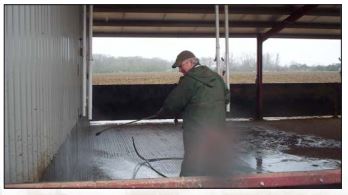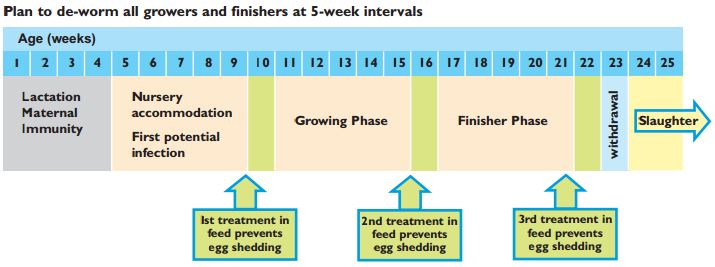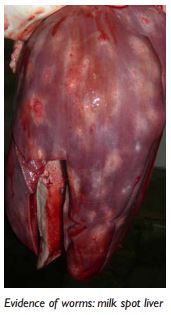



Importance of Regular Worming in Pigs
Large roundworms (Ascaris suum) are endoparasites which cause milk spot liver and are the most prevalent of worms affecting pig productivity. This article from AHDB Pork describes how to keep worms under control in your pigs.Worm burden can result in a loss of up to 10% in daily gain and 13% in feed conversion in growing/finishing pigs, increasing cost of production by 11 p/kg DW through increased food usage and reduced sale weight.
The financial impact of a deterioration of both feed conversion ratio (FCR) and daily liveweight gain (DLWG) by 5% on slaughter pig production to 73 kg deadweight is a rise in the cost of production (CoP) by up to 4.6 p/kg deadweight.
Targets:
- To achieve a worm-free herd
- To improve the growth and efficiency of the growing herd
- To improve animal health and welfare in both short and long term
Management Guidelines
- Assess the worm burden on the farm in consultation with your vet. The BPEX Pig Health Scheme (BPHS) provides data on milk spot livers.
- Develop a suitable control programme appropriate for the level of infection and production system. The aim should be to limit the production of eggs by maturing worms. Use a suitable wormer to achieve desired outcome.
- Adhere strictly to the programme to achieve worm control.
- When worm burden is under control then stick to a simple preventive programme to limit the risk of future burdens.
- In outdoor production, when moving site, always plan the move with a worming programme to minimise the introduction of eggs to the new environment.
Biosecurity
- Isolate incoming stock and treat against worms before introduction into herd.
- Prevent the spread of eggs into and around the unit by ensuring boots, tools and other such vectors are clean.
General Hygiene
- Adopt an all-in all-out policy where possible.
- Pressure wash using detergent and disinfect at every opportunity.Where it is known a high burden has been present the use of a horticultural flame gun to heat pen floors is very effective at destroying eggs - taking the appropriate Health and Safety precautions into account.
- Avoid using stone or soil floors often found in straw yards.
Record and Monitor
- Record all completed actions with dates, as required in your de-worming and worm prevention programme. Continuously re-assess the worm burden and review with your vet.
- Monitor progress by reviewing changes in DLWG and FCR that may be linked with your milk spot data from the BPHS.
Practical Guidelines
It is almost impossible to achieve a totally worm (worm egg) free environment but relatively easy to produce a worm-free pig by using appropriate commercially available worming products. Ascaris suum eggs are very robust and can persist for 7 years in the environment.
Therefore with heavy burdens where all-in all-out policy is not possible the emphasis should be on preventing the female worms laying eggs (250,000/day) thus reducing the number of eggs in the environment over time.
Benefits of De-worming
- Improves average daily weight gain
- Improves food conversion ratio
- Reduces the number of liver condemnations
- Reduces susceptibility to respiratory disease (ie pneumonia)
- Improves overall health and welfare of pigs
- Minimises the contamination of the pig environment with worm eggs
Preventive programme where worms are under control
Sows and Boars
- Treat the entire herd simultaneously a minimum of twice per year and preferably three times.
- Ensure all lactating sows are treated at the same time as dry sows.
Incoming Gilts and Boars
- Treat on arrival and while in isolation unit.
- Re-treat on introduction to the main herd.
- Treat when the next routine herd treatment takes place.
September 2015











